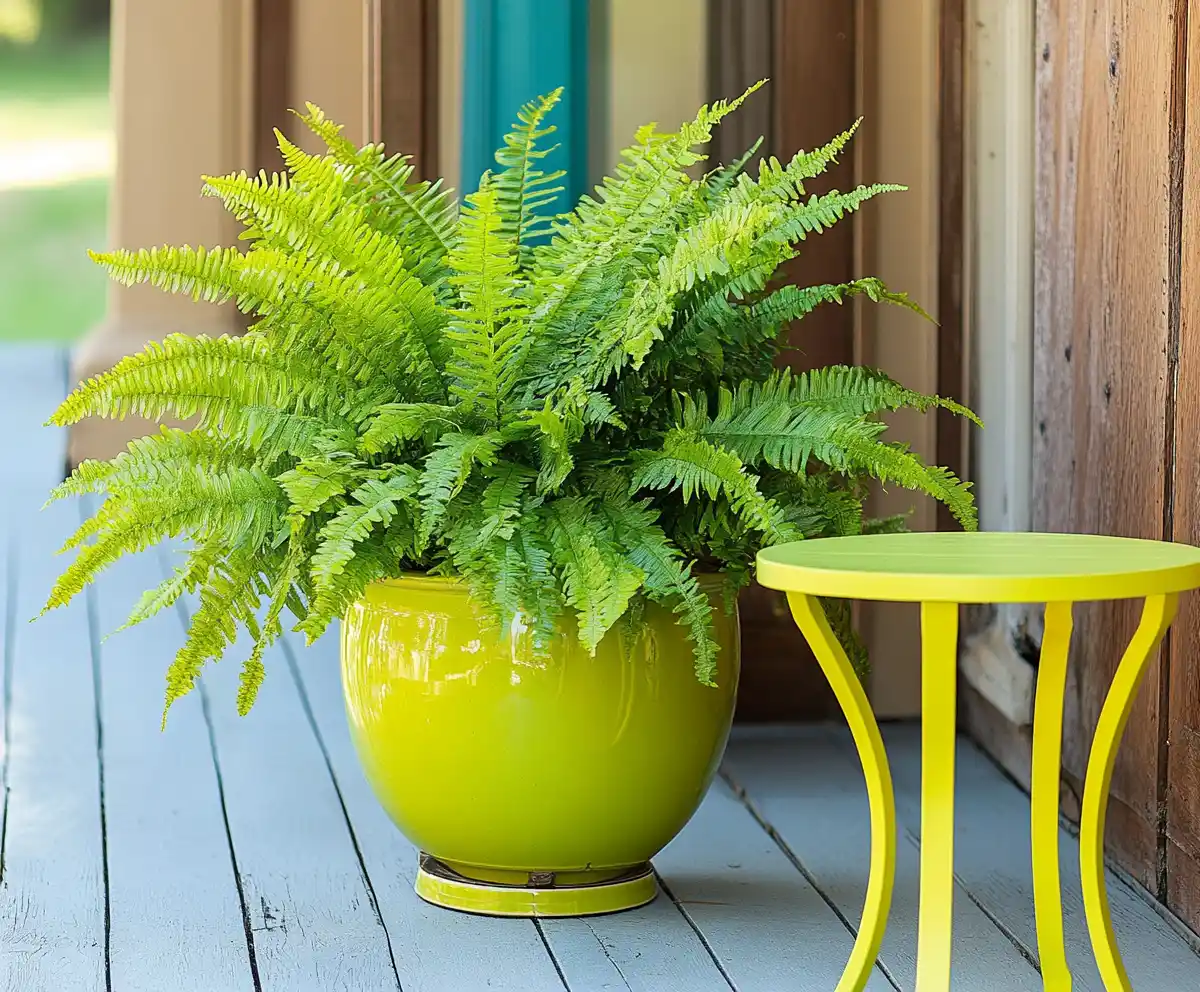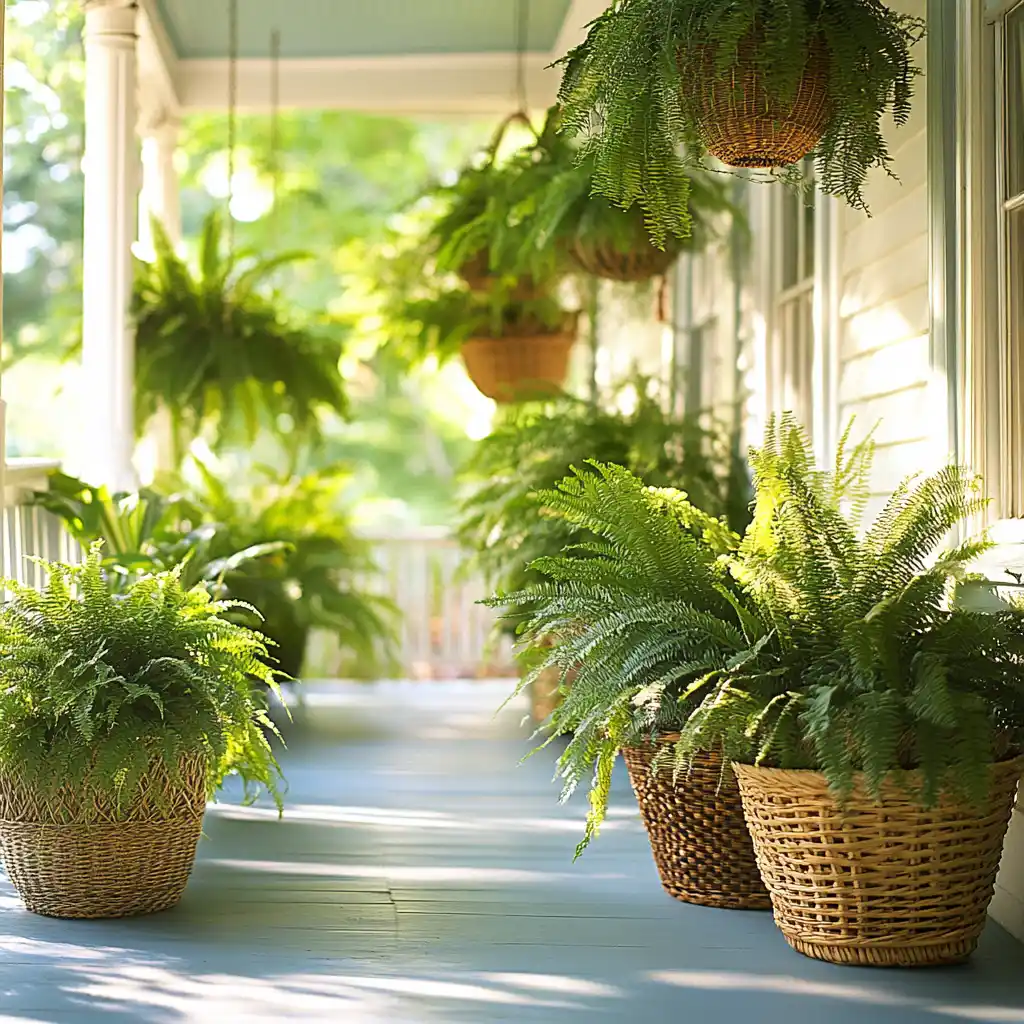If you’ve ever admired a lush, vibrant front porch filled with cascading ferns, you’re definitely not alone. These graceful, tropical beauties bring timeless charm to patios, shaded balconies, and cozy garden nooks. But when it comes to outdoor fern care in pots, success involves far more than just occasional watering. It starts with selecting the right fern variety for your climate, using well-draining containers, and creating a stable care routine that meets their unique needs.
Whether you’re a seasoned gardener or just starting your plant journey, this guide will walk you through how to care for outdoor potted ferns with clear, expert-backed advice. From choosing the right fern species for your hardiness zone to managing sunlight and moisture levels, we’ll help ensure your ferns stay full, green, and healthy. And if you’re designing a porch oasis, don’t miss these front porch fern ideas for inspiration, or explore planter makeover tips to elevate your container display.
Table of Contents
1.🪴 Select the Right Fern Type for Your Zone
When it comes to outdoor fern care in pots, choosing the right fern variety for your local climate is the first step to success. Not all ferns are created equal—some thrive in heat and humidity, while others are better suited for cooler, shadier environments. Knowing your USDA Hardiness Zone helps narrow down the best species for your container garden.
Here are three top-performing fern varieties that are ideal for growing in pots:
🌱 Boston Fern (Nephrolepis exaltata)
Boston ferns are classic and beloved for their lush, arching fronds. They’re best suited for outdoor containers in warm months and grow particularly well in zones 9–11. They love humidity and indirect light, making them perfect for hanging baskets on a shaded porch. If you’re in a cooler zone, treat them as seasonal outdoor plants and bring them indoors before the first frost.
🌿 Kimberly Queen Fern (Nephrolepis obliterata)
Known for their upright, sword-like leaves, Kimberly Queen ferns are a tidy and elegant option for containers. They’re ideal for small patios or entries where vertical space matters. These ferns are more sun-tolerant than Boston ferns and can handle some morning sunlight—but still prefer dappled or indirect light in the afternoon. Great for zones 9–11.
🌴 Macho Fern (Nephrolepis biserrata)
If you’re looking for drama and bold texture, the Macho fern delivers. This larger-than-life fern can grow up to 4 feet tall and 6 feet wide under ideal conditions. It’s well-suited to zones 9–10 and loves warmth and humidity. Be sure you have enough space for its expansive fronds, and consider using oversized containers or hanging baskets for visual impact.
💡 Pro Tip: Not sure what zone you’re in? A quick search of the USDA Hardiness Zone Map can help you determine your region and guide your fern selection.
Selecting the proper fern not only boosts your odds of gardening success but also cuts down on pest issues, wilting, and transplant shock. Choose wisely, and your porch or patio will reward you with vibrant, green growth all summer long.
2.☀️ Place in Ideal Light (Bright Shade)
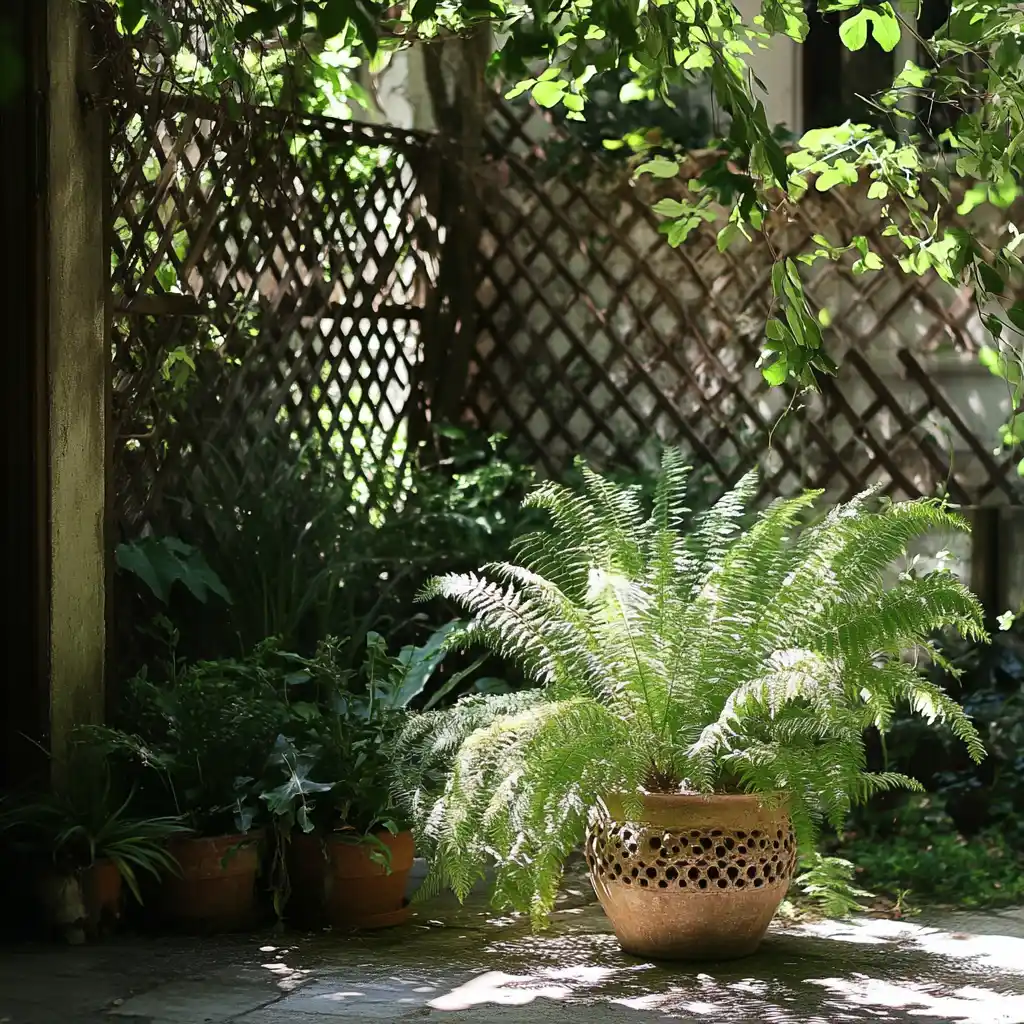
Getting the lighting right is one of the most important parts of outdoor fern care in pots. These delicate plants are native to forest floors, where they receive filtered sunlight and thrive in the gentle glow of dappled light. Mimicking this environment at home can make the difference between a flourishing fern and a struggling one.
🕶️ Skip the Harsh Sun
Most outdoor ferns do not tolerate direct afternoon sunlight. If the leaves start to yellow or dry out, it’s a clear sign of sun stress. Instead, aim for:
- Bright, indirect light
- Dappled morning sun under a tree canopy
- Filtered light through sheer curtains or porch overhangs
- Eastern exposure, where plants get gentle morning rays
Placing your potted ferns on a covered porch, in a shaded balcony corner, or under a pergola gives them the perfect lighting balance.
🔎 How to Tell if It’s Too Much Light
Your fern will “talk” to you through its fronds. If the foliage turns dull green or starts crisping at the edges, it’s likely receiving too much direct light. In that case:
- Move it to a shadier spot
- Rotate the pot weekly for even light exposure
- Consider adding a sheer sunshade or lattice barrier
📝 Label Warning
Be cautious of nursery plant labels that say things like “part sun” or “partial shade”. These terms are vague and often misleading. When in doubt, go for more shade than sun, especially in warmer climates.
🌤️ Bonus Tip: If you’re growing ferns in hanging baskets, try rotating them every few days to ensure symmetrical growth and avoid sunburn on one side.
By carefully placing your ferns in optimal lighting, you’ll create an environment where they can thrive with minimal fuss.
3.🪴 Use Well-Draining Pots
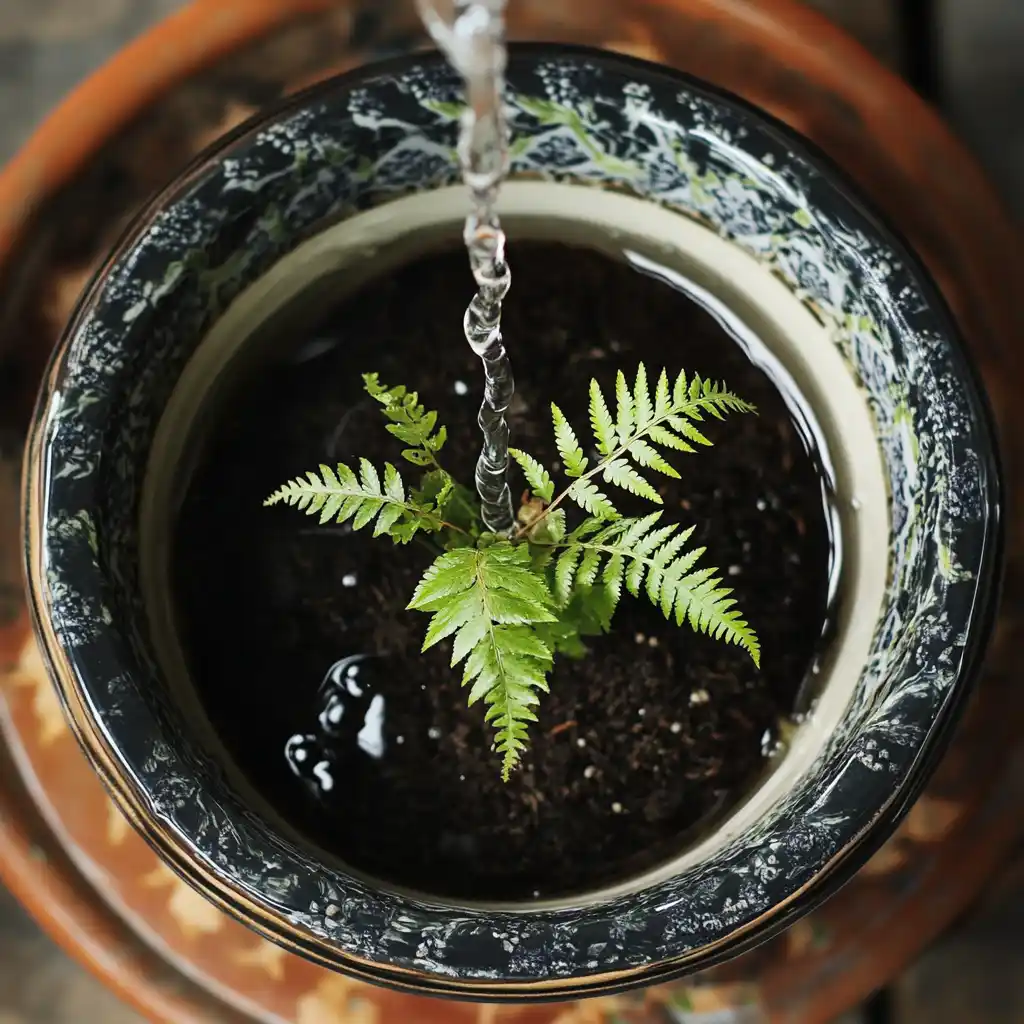
One of the biggest mistakes new gardeners make with potted ferns is overlooking the importance of drainage. Ferns love consistent moisture, but they absolutely hate soggy roots. Choosing the right container setup can make a huge difference in your plant’s health and longevity.
🚫 Say No to Soggy Soil
Ferns are prone to root rot when left sitting in water. That’s why using pots with proper drainage holes is essential. If water can’t flow freely out of the pot, the roots can become waterlogged and suffocate.
Here’s how to ensure your pots are fern-friendly:
- Always choose containers with multiple drainage holes
- Avoid ceramic or decorative pots without holes unless used as outer covers
- Never allow water to pool at the bottom of a sealed container
🪟 Nursery Pot Inside a Decorative Pot (Best of Both Worlds)
Most ferns come in lightweight plastic nursery pots that already have great drainage. A smart trick is to keep your fern in its nursery pot and simply place it inside a larger, prettier container. This setup offers:
- Easier watering
- Better root airflow
- Simple removal when needed for fertilizing or inspecting roots
- Less risk of overwatering
💧 Watering Tip: Using the nursery pot method allows you to water from the bottom, encouraging deep root growth while preventing over-saturation on the soil surface.
🌿 Choosing the Right Pot Size
Avoid pots that are too large for your fern. Ferns prefer a cozy environment with roots that are gently crowded. If you upsize, do so gradually. A pot that’s too big can lead to excess water retention and uneven moisture distribution.
By ensuring good drainage and a snug container, you set the stage for your fern’s root system to thrive—one of the most overlooked secrets in proper outdoor fern care in pots.
4.🧂 Fertilize with Epsom Salt
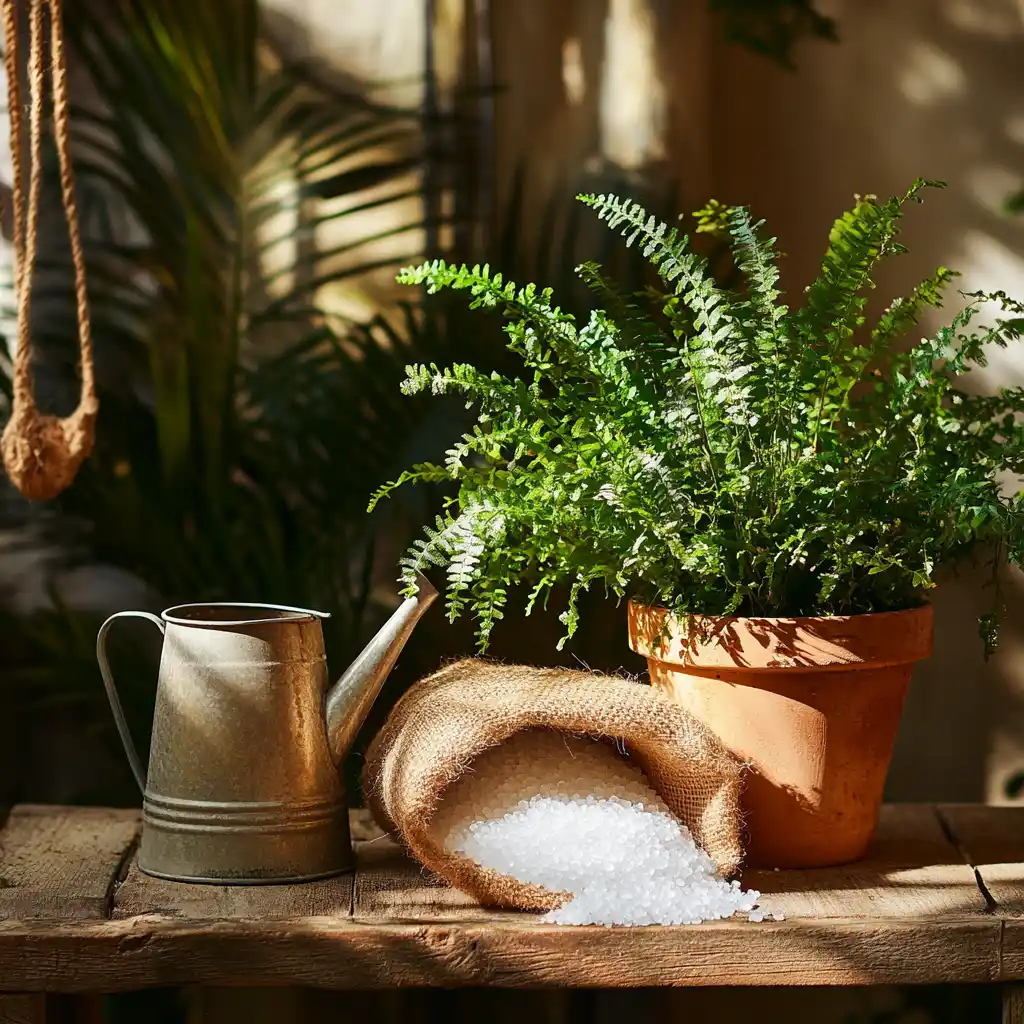
It might sound unconventional, but using Epsom salt is a tried-and-true secret among gardeners for vibrant, lush fronds. When done correctly, this natural supplement can be a game-changer in your outdoor fern care in pots routine.
🌱 Why Epsom Salt Works for Ferns
Epsom salt isn’t actually salt—it’s a mineral compound made of magnesium sulfate, two essential nutrients that promote healthy chlorophyll production and overall plant vigor.
Benefits include:
- Greener fronds
- Stronger root systems
- Better nutrient absorption
- Improved resistance to pests and stress
Fern foliage, especially in pots, can sometimes turn pale or lackluster due to nutrient deficiencies. A simple Epsom salt boost can often revive their rich green color.
🧴 How to Apply It
Monthly feeding is typically enough during the growing season. Here’s a safe and effective method:
- Mix 1 tablespoon of Epsom salt with 1 gallon of water
- Apply directly to the soil around the base of the fern
- Avoid spraying the fronds directly to prevent potential burn in sunlight
You can alternate this with a slow-release fertilizer once every 6–8 weeks if your fern needs additional feeding.
🔁 Combine with Regular Care
Remember, Epsom salt is not a complete fertilizer, so don’t rely on it alone. Think of it as a supplement—like vitamins for your fern. Pair it with:
- Regular watering
- Proper drainage
- Adequate light
🌿 Expert Insight: You might notice more rapid growth and fuller fronds within just a couple of weeks after starting Epsom salt treatments—especially if your fern was nutrient-deprived.
Using natural, cost-effective solutions like Epsom salt can help you maintain happy, healthy plants without breaking the bank or turning to harsh chemicals. It’s one more way to simplify your outdoor fern care in pots while achieving beautiful results.
5.💧 Maintain Moisture and a Consistent Watering Schedule
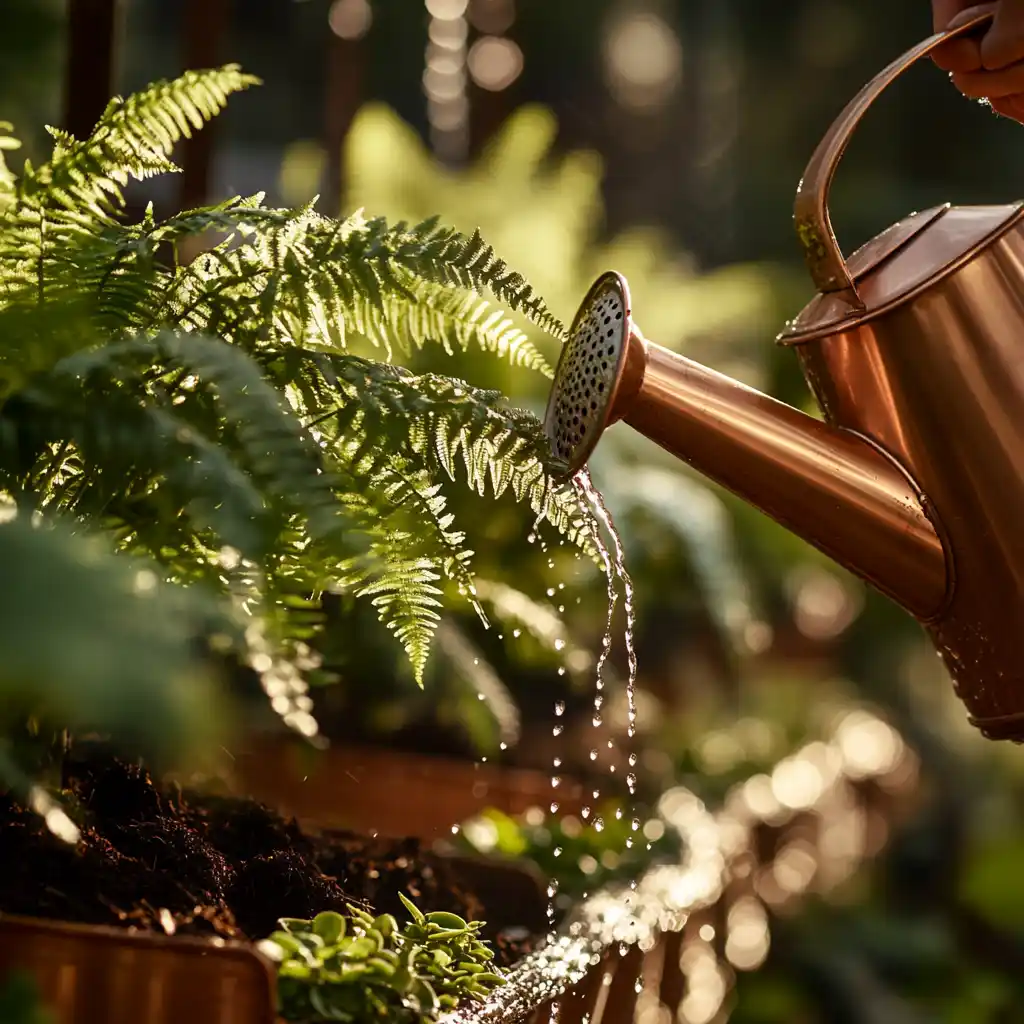
When it comes to potted ferns, water is everything. These humidity-loving plants don’t just prefer moist soil—they depend on it. However, too much of a good thing can lead to trouble, which is why balance is key in your watering routine.
🌿 Ferns Love Moisture (But Hate Soggy Feet)
The goal is to keep the soil consistently moist, not waterlogged. Most ferns, especially when grown in containers, have dense root systems that dry out faster than you might expect—particularly in warmer climates or windy areas.
Here’s how to keep them happy:
- Water daily in hot weather or if your pot dries out quickly
- In cooler weather, scale back to every other day or as needed
- Always check the top inch of soil—if it feels dry, it’s time to water
- Avoid letting your fern sit in a saucer full of water (root rot alert!)
🪣 Best Watering Practices
- Use a watering can with a narrow spout to aim directly at the soil
- Water in the morning to give your plant time to dry off before nightfall
- For hanging baskets, soak the entire pot until water runs through the bottom
💦 Bonus Tip: Bottom watering works especially well for nursery pots inside decorative containers. Just place the pot in a shallow tray of water for 15–20 minutes and let the roots soak it up.
☀️ Watch for Heat and Wind
In hot, dry, or windy conditions, ferns may need twice-daily watering. Hanging baskets, in particular, dry out faster because they’re more exposed to air circulation and sun.
You can also help maintain moisture by:
- Adding a layer of organic mulch on top of the soil
- Grouping ferns together to increase ambient humidity
- Mist-spraying fronds lightly on particularly dry days
Keeping your watering routine consistent is the heart of great outdoor fern care in pots. Once you get into a rhythm, your ferns will reward you with full, lush, and vibrant foliage.
6.🕵️ Inspect for Pests & Sun Damage
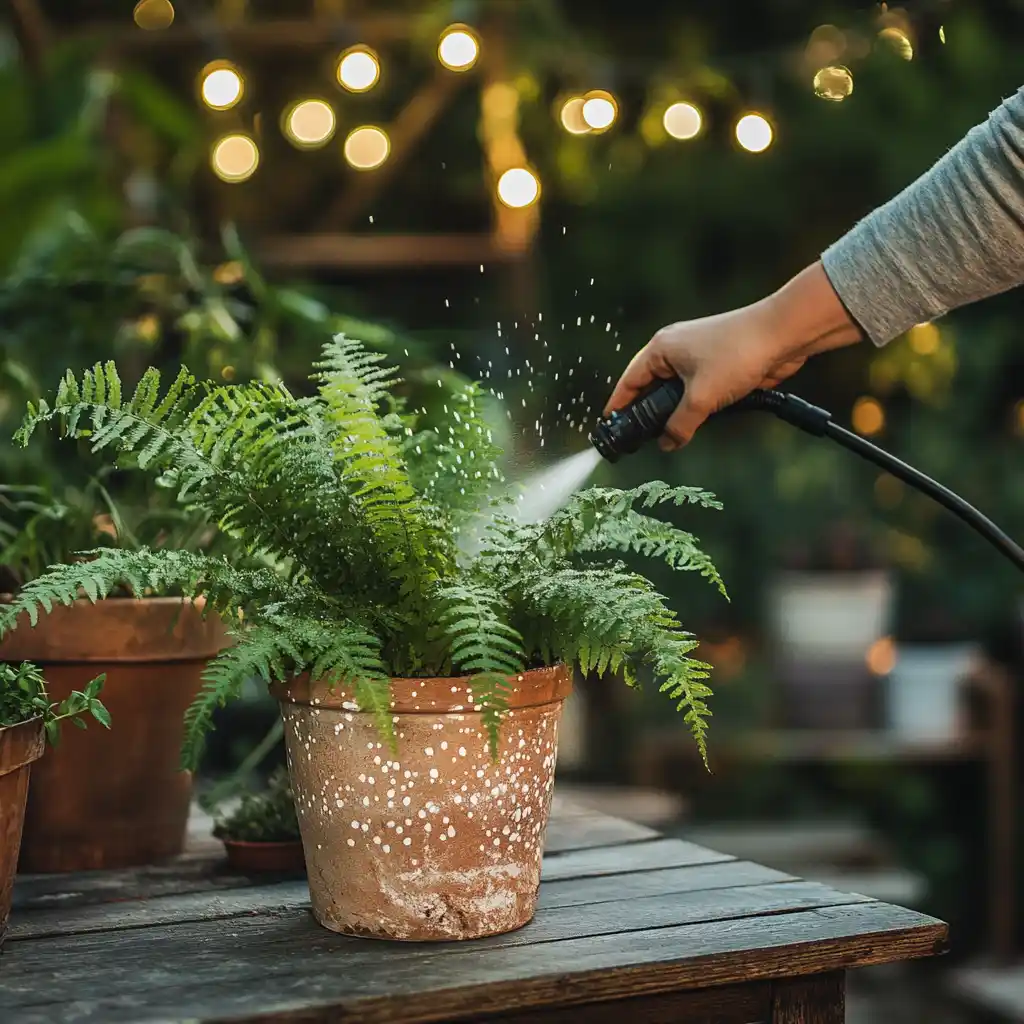
Even the healthiest ferns can run into occasional trouble, especially when they’re living outdoors. A key part of consistent outdoor fern care in pots is regularly inspecting your plants for signs of pests, stress, or sun damage—before small problems turn into big ones.
🐛 Common Pests to Watch For
Ferns aren’t typically magnet plants for pests, but they’re not immune. A quick weekly check can help you spot:
- Aphids – Tiny green, black, or white insects that cluster on new growth
- Spider mites – Fine webbing and tiny red or white specks under leaves
- Scale insects – Small, oval brown bumps on stems or fronds
- Fungus gnats – Tiny flies hovering near wet soil (a sign of overwatering)
If you find pests, try these safe treatments:
- Rinse with a strong spray of water to dislodge them
- Use neem oil or insecticidal soap for persistent infestations
- Allow the top inch of soil to dry out to discourage gnats
🪺 Bonus Surprise: Sometimes you’ll discover friendly wildlife like small birds nesting in your hanging baskets. If so, enjoy the show and let nature take its course!
🌞 Signs of Sun Stress and How to Fix It
Ferns are very communicative when they’re unhappy with light conditions. Yellowing, browning, or crispy fronds typically indicate too much direct sun. Dull or faded fronds might mean too little light.
Here’s what to do:
- Move your fern to a shadier spot or one with indirect light
- Trim off damaged fronds to encourage new healthy growth
- Rotate the pot regularly to ensure even exposure
Ferns are adaptable, but they can’t recover well from prolonged sun damage. That’s why weekly visual inspections are one of the easiest ways to maintain vibrant, healthy plants.
❓ Frequently Asked Questions: Outdoor Fern Care in Pots
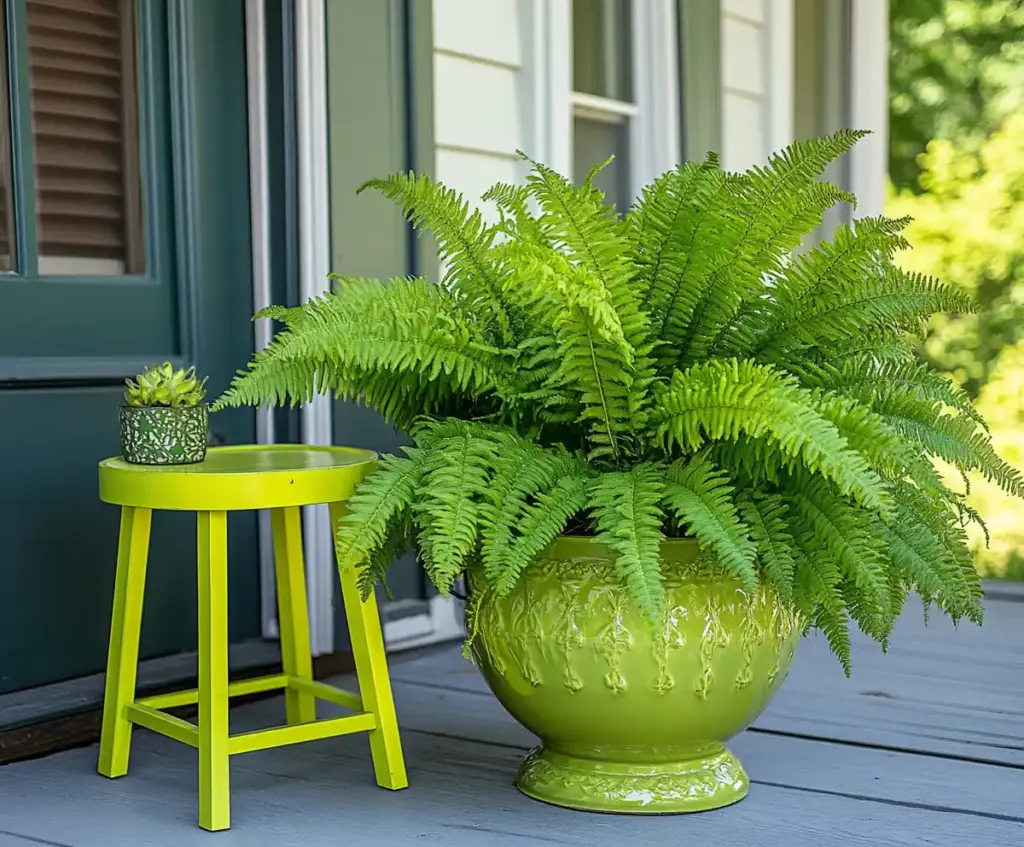
🌿 How often should I water ferns in outdoor pots?
Ferns in containers usually need daily watering during hot or dry weather, and every 1–2 days in cooler months. The goal is to keep the soil consistently moist but not soggy. If the top inch of soil feels dry, it’s time to water.
☀️ Can outdoor potted ferns handle direct sunlight?
Most ferns prefer bright shade or dappled sunlight. Direct afternoon sun can scorch their fronds, causing yellowing or crisp edges. When practicing good outdoor fern care in pots, always place them in a location with filtered or indirect light for best results.
🪴 What type of container is best for outdoor ferns?
Use pots with excellent drainage—ideally plastic nursery pots nested inside decorative containers. This prevents overwatering while maintaining moisture. Drainage holes are a must to avoid root rot in your fern care routine.
🧂 Is Epsom salt safe for all fern varieties?
Yes! Epsom salt is a safe and effective supplement for most ferns. It provides magnesium and sulfur, helping fronds stay green and vibrant. Apply monthly by mixing 1 tablespoon with a gallon of water and pouring it into the soil—not directly on the leaves.
🐛 What pests should I watch for in outdoor fern care?
While ferns are relatively low-maintenance, they can attract aphids, spider mites, scale insects, and fungus gnats. Regularly check the fronds and soil. A strong spray of water or neem oil usually controls minor infestations.
🧊 Can I leave potted ferns outside during winter?
That depends on your USDA hardiness zone and the fern type. In colder zones (below 9), many ferns need to be brought indoors or protected with frost covers. Check your zone and choose ferns accordingly for better success with outdoor fern care in pots year-round.
🌿 Conclusion
Growing ferns in containers is one of the simplest and most rewarding ways to bring lush greenery and texture to your outdoor living space. With the right care—including selecting the best fern for your climate zone, providing ideal light, using well-draining pots, and maintaining a steady watering and feeding schedule—you can easily master outdoor fern care in pots.
Success with container fern gardening doesn’t require perfection. It’s all about consistency, attention to detail, and responding to your plant’s needs over time. Whether you’re just starting out or refining your green thumb, these tips for outdoor fern care in pots are designed to help your plants thrive.
If you’re looking to refresh your patio setup, you might also enjoy exploring sunny porch plants for full-sun areas or front porch decor ideas that pair beautifully with your fern displays.
Happy planting—and may your potted ferns be healthy, vibrant, and the pride of your porch!

